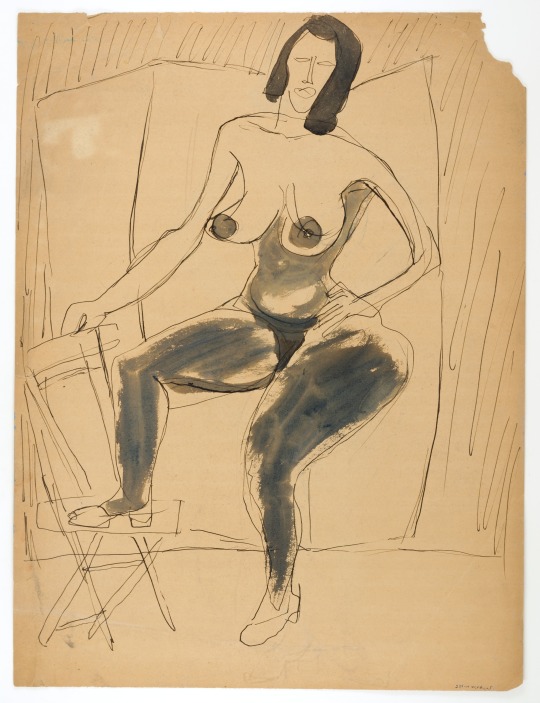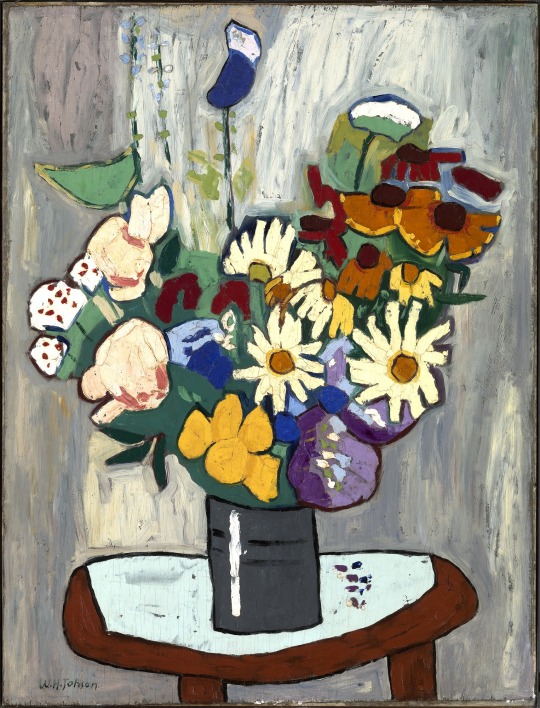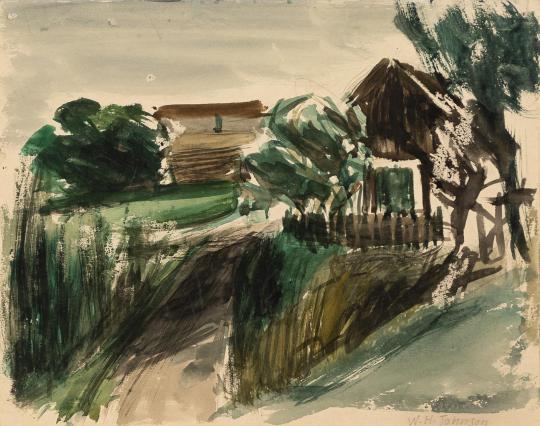#William H. Johnson
Text

William H. Johnson, New Land Breaking, 1941
#william johnson#william henry johnson#william h. johnson#african american ar#african american artist
257 notes
·
View notes
Text

William H. Johnson, Blind Singer, ca. 1940. Screenprint with tempera additions.
Johnson was among the foremost painters of African-American life during the Harlem Renaissance. Born in South Carolina and educated in fine arts in New York and Provincetown, Johnson spent most of his time from the mid-1920s to the late 1930s in Europe, where he was influenced by Post-Impressionism and Expressionism. After achieving critical acclaim abroad, he returned to New York permanently in 1938 under the threat of war and with a desire to reconnect to his roots. The move produced a dramatic change in his work. Assigned by the government's Works Progress Administration to teach at the Harlem Community Art Center, Johnson became immersed in the sights, sounds, and people of New York's African-American community, which he captured in compositions of flat shapes, patterned designs, and brilliant colors that were distinctly modernist in their simplicity and directness.
During his lifetime, Johnson created more than seventy-five prints. While in Europe he produced woodcuts and linoleum cuts, usually with hand coloring, inspired by the raw power of German Expressionism. After returning to New York, he took up screenprint and pochoir, techniques that suited his new embrace of simplified forms and bold colors. He printed these works on assorted found papers and often completed his images by hand with tempera, making each print slightly different from the next. He frequently experimented with subjects by printing compositional variants and also rendering them in drawing and painting, each format enriching the other, but with the printed versions the most simplified of all.
Notable among Johnson's New York prints are those that capture the essence of Harlem's fashion, music, and dance. This print, entitled Blind Singer, shows a pair of musicians in an open-air performance that was common on the city's bustling streets. The composition's flatness, pure color, and orchestrated angularity endow this still image with a sense of rhythmic motion and dynamic energy.
--Judy Hecker, in Deborah Wye, Artists and Prints: Masterworks from The Museum of Modern Art
Photo & text: MoMA
#vintage New York#1940s#William H. Johnson#painter#painting#Harlem Renaissance#Black painters#African-American artist#printmaker#vintage Harlem#Harlem culture
40 notes
·
View notes
Text

William H. Johnson, Operation Room, 1942
9 notes
·
View notes
Text

William H. Johnson - Opstilling med Blomster (Floral Still Life)
21 notes
·
View notes
Text

Homesteaders, William H. Johnson (1942) // Colin Meloy, Wonder (2009)
3 notes
·
View notes
Text

William H. Johnson (African American 1901-1970), Standing Female Nude with Leg on Chair, ca. 1939-1940. Pen and ink and ink wash on paper, 24 1/8 x 18 1/4 in. | 61.3 x 46.4 cm. (Source: Smithsonian American Art Museum)
#art#artwork#modern art#contemporary art#modern artwork#20th century modern art#20th century contemporary art#standing female nude#female figure#human figure#female nude#American artist#American art#modern American art#contemporary American art#African-American artist#African American art#William H. Johnson
3 notes
·
View notes
Text

William H. Johnson (American, b. 1901)
Early Morning Work, 1940
Oil on burlap
10 notes
·
View notes
Photo

William H. Johnson, Flowers, 1939-1940, oil on plywood
9 notes
·
View notes
Text

Daily Painting
William H Johnson
THREE DANCERS (1944)
0 notes
Text

Laura Wheeler Waring, “Girl with Pomegranate”, ca. 1940, oil on canvas

Winold Reiss, “Langston Hughes”, 1925, Pastel on illustration board

Winold Reiss, “Alain Leroy Locke”, 1925, Pastel on illustration board
The Harlem Renaissance and Transatlantic Modernism at The Metropolitan Museum of Art showcases some of the outstanding work created during this time period. The exhibition also provides some background on the artists, their peers in the art world, and their community.
From the museum-
The Harlem Renaissance emerged in the 1920s as one of the era’s most vibrant modes of artistic expression. The first African American-led movement of international modern art, it evolved over the next two decades into a transformative moment during which Black artists developed radically new modes of self-expression. They portrayed all aspects of the modern city life that took shape during the early decades of the Great Migration, when millions of African Americans left the segregated rural South in search of freedom and opportunity in Harlem and other expanding Black communities nationwide.
This exhibition explores how artists associated with the “New Negro” movement-as the Harlem Renaissance was originally known, after influential writings by the philosopher Alain Locke and others-visualized the modern Black subject. It reveals the extensive connections between these artists and the period’s preeminent writers, performers, and civic leaders. At the same time, it reconstructs cross-cultural affinities and exchanges among the New Negro artists and their modernist peers in Europe and across the Atlantic world, often established during international travel and expatriation.
This complex, multilayered story unfolds through portraits, scenes of city life, and powerful evocations of Black history and cultural philosophy. Highlights include seldom-seen works from historically Black colleges and universities and culturally specific collections. Across its broad sweep, opening with founding ideas and concluding with activist imagery made on the cusp of the civil rights era, it establishes the critical role of the Harlem Renaissance in the history of art as well as the period’s enduring cultural legacy.

Horace Pippin, “Self Portrait”, 1944, Oil on canvas, adhered to cardboard; and “The Artist’s Wife”, 1936, Oil on linen
The caption for the above paintings reads-
Contemporary artist Kerry James Marshall has described Pippin’s self-portrait as a “monumental statement of self-confidence.” In this small painting, tightly cropped at bust length, Pippin gazes confidently at the viewer, his firmly drawn likeness reflecting a well-disciplined hand. Pippin portrayed his wife, Jennie Ora Fetherstone Wade Giles, at three times the scale of his own image, but he unified the two paintings by using a similar palette. Jennie’s blue dress is echoed in the background of his portrait, while the background of her portrait is picked up in the artist’s tie and button-down shirt.
The portraits in the exhibition are not the only standouts. Below are a few more selections.

Suzanna Ogunjami, “Full Blown Magnolia”, 1935, oil on burlap

William H. Johnson, “Flowers”, 1939-40, oil on plywood


Aaron Douglas, “The Creation”, 1935, and "Aspiration", 1936,Oil on masonite
From the museum about artist Aaron Douglas–
A core objective of the Harlem Renaissance was to portray the history and cultural philosophy that gave shape to a specifically African American identity and worldview. The artist Aaron Douglas, whose monumental murals earned him acclaim as the period’s foremost history painter, was also respected for his masterful use of biblical allegory to convey aspirations for freedom, equality, and opportunity.
Douglas first developed his signature silhouette figural compositions-derived in part from Cubism, Egyptian tomb reliefs, and American popular culture-for book and magazine cover illustrations in the late 1920s. He later elaborated this distinctive style in large-scale works for public projects and institutional commissions nationwide as well as at Fisk University in Nashville, where he established the art department and taught for thirty-eight years. Both Douglas and the sculptor Augusta Savage, founder of a Harlem community art school, created art inspired by the work of the author and composer James Weldon Johnson.

Laura Wheeler Waring, “Mother and Daughter”, 1927, Oil on canvas board
About Laura Wheeler Waring’s painting Mother and Daughter from the museum-
Mother and Daughter is perhaps the most direct engagement by a prominent Black artist of this era with the controversial topic of racially mixed families; its very existence was a disruption of the silence on the subject within certain segments of society. Waring experimented with some of the modernist pictorial devices favored by Alain Locke in her portrayal of a Black mother and her white-presenting daughter, rendering them not as specific individuals but as generic types emblematic of the omnipresence of racially mixed families. Flattening their near-identical facial features in profile, Waring established the true subject of the painting via the title and through the work’s most prominent element: the divergent skin tones that point to the subjects’ radically different paths through a social life defined by color lines.

Beauford Delaney, “Dark Rapture (James Baldwin)”, 1941, Oil on masonite
Finally, this portrait of James Baldwin by Beauford Delaney was also a highlight.
From the museum about the work-
Delaney met the writer and civil rights activist James Baldwin in 1940. Finding common ground on multiple fronts-intellectual, social, and artistic-the two gay men began a friendship that would last thirty-eight years. Dark Rapture, the first of Delaney’s several portrayals of Baldwin, presents the author in a thickly painted, expressive tonal study of reds, browns, and blues against a brightly hued landscape. Both introspective and joyous, Dark Rapture stands as a visual manifestation of queer camaraderie, identity, and the search for belonging in the modern world.
This exhibition closes 7/28/24.
#Harlem Renaissance#The Metropolitan Museum of Art#Aaron Douglas#Alain Locke#Art#Art Show#Art Shows#Augusta Savage#Beauford Delaney#Horace Pippin#James Baldwin#James Weldon Johnson#Langston Hughes#Laura Wheeler Waring#New York Art#New York Art Shows#NYC Art Shows#Painting#Suzanna Ogunjami#The Met#William H. Johnson#Winold Reiss
1 note
·
View note
Text

William H. Johnson Booker T. Washington, Legend. 1945. Oil on plywood: 82×64 cm (32×25 in).
#oil painting#black excellence#art#booker t washington#black tumblr#william h johnson#1940s#history#academia#education#art history#activism#black history#learning#community#student#inspiration#literature#music#culture#📚
130 notes
·
View notes
Text

William H. Johnson, Jesus and Three Marys, 1939
177 notes
·
View notes
Text

ok but like abraham lincoln vampire hunter if his actual cabinet was there. salmon chase may or may not be a vampire
#abraham lincoln vampire hunter#abraham lincoln#will johnson#joshua speed#william seward#william h seward#salmon p chase#edwin stanton#my art#this movie is horrible#made speed??? a little more??? historically accurate???#he isn’t the guy from iasip anymore
57 notes
·
View notes
Text

William H. Johnson, Woman in Calico, 1944
4 notes
·
View notes
Text

William H. Johnson - Kerteminde Landscape
13 notes
·
View notes
Text
Okay people you know the drill by now. Showing historical figures fanfiction of them:
American Politician edition. Round two!
I never once in my years of existence that I would ever read a fanfiction that had Jimmy Carter and Abby Lee Miller in it. But here we are.
#tumblr poll#tumblr polls#History#History hypothetical#history hypotheticals#historical hypotheticals#historical hypothetical#American history#American presidents#American politicians#Fanfiction#fanfics#ronald reagan#James Buchanan#john adams#james madison#george h w bush#george w bush#Jimmy Carter#Gerald Ford#Al Gore#lyndon b. johnson#william howard taft#john quincy adams
26 notes
·
View notes